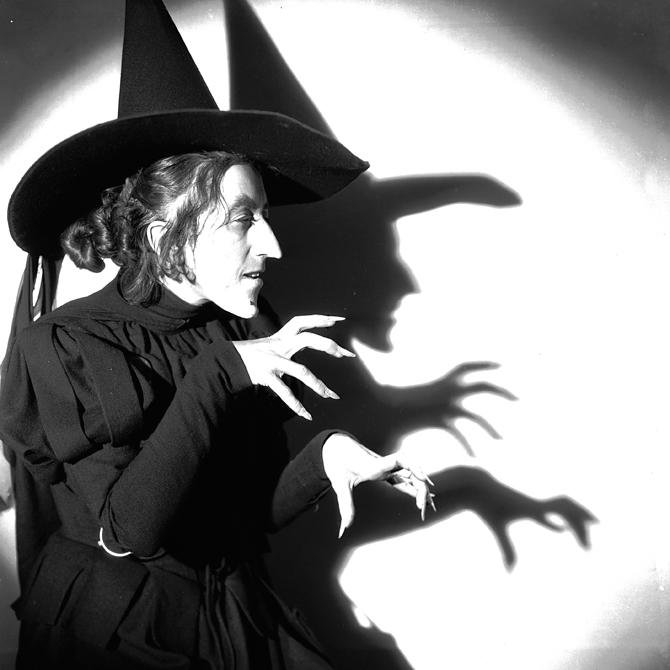Thanks in part to The Wizard of Oz, the word witch has become code for a certain type of dress. Flowing black robes. Black boots. Accessorize as you wish with a broom or a grassy complexion, but on pain of expulsion from the coven, do not forget the peaked, black, wide-brimmed hat.
The hat makes the witch, to paraphrase Mark Twain. And yet the story of this particular hat—where it originated, and how it took on its demonic resonance—is a murky one. That’s largely because history is full of pointy hats, from the tapering hennins favored by medieval noblewomen to the soft Phrygian caps adopted by French revolutionaries (and Smurfs). There are simply too many varieties of pointy hat to describe in a single blog post, more possible antecedents than can be ruled out. But weirdly, one of the earliest incarnations of the conical headpiece is also one of the most familiar: Three female mummies uncovered in the Chinese region of Subeshi [PDF]—known as the “witches of Subeshi”—are famous for covering their hair with large funnel-shaped contraptions of black felt. They look like aunts in a fourth century B.C. outtake from Sabrina the Teenage Witch.
Experts aren’t sure exactly when pointed lids became associated with sorcery. Medieval depictions of witches often show them nude and bare-headed, their long hair mingling with flames and smoke. Woodcuts from the 1600s occasionally outfitted spell-casters in common bonnets. It wasn’t until the 1710s and 1720s that children’s chapbooks in England began illustrating supernatural tales with crones in peaked hats. Fueled by the popularity of these “penny merriments,” the stereotype caught on quickly. Western European artists began to modify images of witches from the Middle Ages, lengthening the blunt tips of their caps into devilish spikes. According to Gary Jensen, a former professor at Vanderbilt and author of The Path of the Devil: Early Modern Witch Hunts, the pointed cap became an easy, evocative way to signal dark magic. Witches in peaked hats started to appear on postcards from the American colonies. Legendary figures like Mother Goose and La Belfana—an Italian mother deranged by the death of her infant, said to fly through the night air delivering gifts to children—acquired pointy hats. During the Salem Witch Trials, witnesses reported seeing the devil: “a large black man with a high, crowned hat.” Later, Victorian-era storybooks further developed the theme.
But this timeline doesn’t tell us why conical hats were first chosen to represent evil. Less substantiated theories invoke old stories of witches in medieval England being forced to don crowns shaped like church steeples. The caps were supposedly meant to draw down God’s grace in a last-ditch effort to redeem the wearers. Or perhaps the credit goes to folk artists, who as early as the 1500s used pointed hats to subtly evoke devil horns, though rarely on women. (Goya’s 1798 oil painting, “Witches in the Air,” is an eerie outgrowth of this trend.)
The two explanations that seem most plausible have to do with real-life marginalized groups. In his book, Jensen describes how the 1215 Fourth Council of the Lateran required all Jews to identify themselves by wearing the Judenhat (“Jewish hat” or “horned skullcap”). The style soon became a target for Anti-Semitism. Artists painted devils muttering curses beneath Jewish crowns. In 1431, Hungarian legal codes required first-time sorcery offenders to walk among their peers in “peaked Jews’ caps.” Medieval representations tying Jews to Satan were nothing new, and by the late 13th century, Jewish attributes had soaked up enough ugly significance to tar all “unbelievers, hypocrites, heretics, pagans, and demons,” Jensen writes. So does the Wicked Witch of the West’s iconic chapeau reflect an ancient association between black magic and the Chosen People?
A second theory holds that the pairing of witches and peaked hats flows from anti-Quaker prejudice. A minority sect in colonial America, the Quakers were thought to consort with devils and dabble in witchcraft. Puritan backlash against the community was cresting in the mid-18th century, at around the same time that the figure of the cone-headed spell-weaver began to insinuate herself into American folklore. There’s just one problem with this hypothesis: Quakers didn’t wear pointed hats. But the theory may yet hold water. Quaker headgear was itself the locus of squall and controversy. The movement’s founder, George Fox, famously refused to doff his hat in the presence of Cromwell’s ministers. “When the Lord sent me forth into the world He forbade me to put off my hat to any, high or low,” Fox told the magistrates. (Why? Because such “hat-honour” was “invented by men in the fall and in the alienation from God.”) Fox endured three separate prison stays for his disrespect; in the colonies, Friends honored his example by keeping their hair covered at all times. In 1876, an American magazine called Littell’s Living Age hailed the Quaker hat as “the war-standard of this quaint army of non-fighters.” Colonial Puritans, though, were not so kind, at times using the hats as an excuse to prosecute their religious rivals. Jensen suspects that it was a short hop from the Quaker cap as a symbol of doctrinal insubordination to the witch’s hat as an emblem of infernal craft.
Of course, most modern people who identify as witches don’t actually wear the stereotypical witch’s hat. (They don’t have to pull on flowing garments either, although certain rituals are associated with color-coded robes.) Still, the peaked cap holds special significance for some Wiccans, who see it as a visual representation of the Cone of Power they draw on for their spells.
